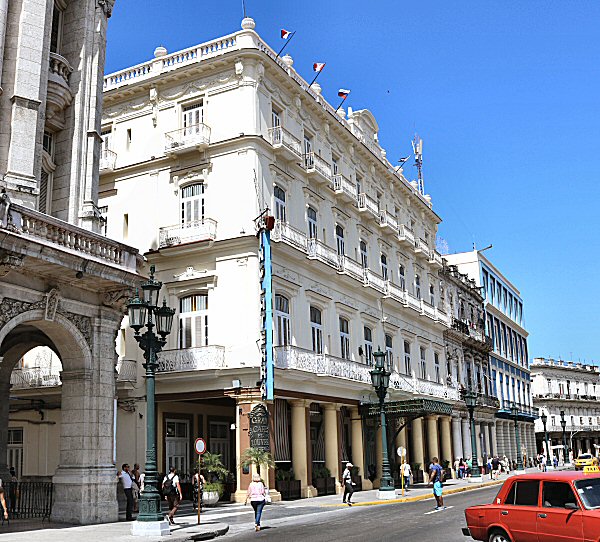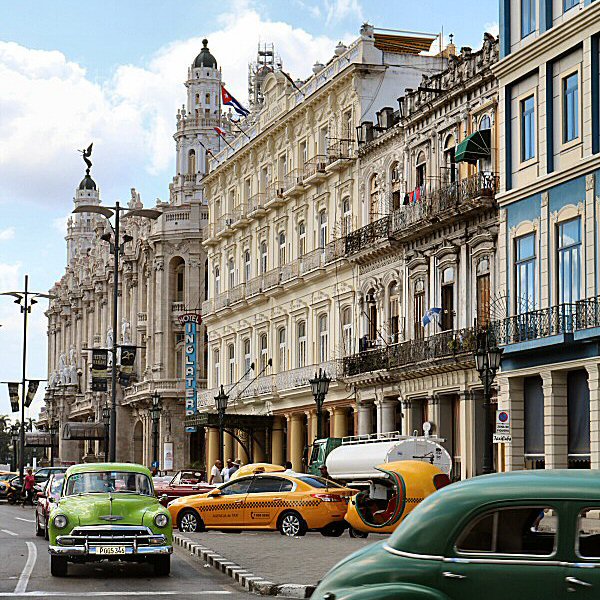
The Hotel Inglaterra is located on the
Paseo de Martí #416, where it intersects with the San Rafael
street, opposite the Parque Central.

The corner of the Alameda del Prado
(current Paseo de Martí) and the San Rafael street gradually
evolved into a cultural center of the city, in that the young
native people with ideals of independence and separation from
Spain met and exchanged opinions. Thus, the section of the
current Paseo de Martí between the San Rafael and the San Miguel
streets that runs along the current Hotel Inglaterra and Hotel
Telégrafo was called as Acera del Louvre (Sidewalk of the
Louvre), receiving its name from El Louvre coffee shop. These
young people that had high cultural level in the majority, were
called as “Boys of the Sidewalk of Louvre”.
In 1866 protests erupted again in the
Acera del Louvre, when the Spanish merchants offended the Cubans
by giving back the tickets of the performance that would be held
in the Teatro Tacón to donate the widow of the renowned
scientist Ramón Zambrana. The humanist Ramón Zambrana was a
medical doctor and writer that contributed so much to the
science and the literature in Cuba. He died in a state of
poverty, leaving her wife alone with her five children.
The Acera del Louvre was a place where
everybody could feel full freedom, hence a Spanish military
broke his sword to protest the execution of the eight medical
students in 1871 that were accused of desecrating of a corpse,
although they didn’t commit any crime.
The Acera del Louvre had another
feature to be mentioned: in those days there was a gymnasium
near the Café Louvre where the Cubans strengthen their bodies,
practice shooting and improve their skill in handling sabers and
swords. Externally it seemed as a sports center, but in fact,
many young Cubans were attending there to prepare for the fight
for independence. It is also interesting that the costs of the
gymnasium were financed by the Creole Domingo del Monte y
Aponte, the first professional critic of the island that would
be accused of treason later because of his non-conciliatory
publications and talks against the Spanish rule.
In 1875 Don Joaquín Payret decided to
build a new theatre across the current Paseo de Martí that would
be named after his surname and sold the Café Louvre to finance
the new construction. In the same year, a two-story building was
constructed adjacent to the coffee shop. Le Gran Hotel and the
Restaurante Inglaterra were inaugurated in this building. The
restaurant and later the hotel were honored by the name of the
principal world power of the time. The owners of the
neo-classical hotel were Manuel López and Urban González.
After the Ten Years’ War the social and
political activity in the Acera del Louvre resumed by the return
of the young fighters. In 1879, the Café Louvre witnessed the
speech, made by José Martí to pay tribute to the journalist
Adolfo Márquez Sterling that was conducting a campaign against
the autonomists in his Cuban newspaper La Discusión.
After the reconstruction in 1886, the
Hotel Inglaterra grew in a floor more. In 1890 the hotel was
decorated with gleaming golden mosaics and embossed grills. In
the same year, the hotel had a well-known guest: Antonio Maceo,
the Major General of the Liberation Army. Antonio Maceo stayed
for six months in this hotel. It was an event that increased the
enthusiasm and emotion of the young people in the Acera del
Louvre.
In 1895, when Winston Churchill was
visiting the island as a military reporter and a correspondent
of the Daily Graphic (the first daily illustrated newspaper in
England) during his five months’ leave from the army, he stayed
in the Hotel Inglaterra. In his report about the
Spanish-American-Cuban War, he gave also details about the
national weapon of the Cuban insurgents, called the machete (a
short knife with wide blade that can be used separately or as
bayonet).
In 1901, the hotel was renovated
completely by adding electricity to the lighting system,
telephones in each room, bathroom in each room with hot and cold
water facility and a telegraph line to the hotel. 300.000 gold
pesos were spent for the renovation that placed the Hotel Ingleterra with its comfortable rooms in the first row of the
best hotels in America.
In 1914, the iconic glass canopy was
added to the entrance and the hotel reached its fourth floor.
The four-stars hotel with its 83 rooms turned the economic
crisis that the World War I generated, into advantage. In the
coming years the hotel was greatly preferred by the American
tourists due to the proximity of Cuba to the US, but much more
due the prohibition of the manufacture, commercialization and
consumption of alcoholic beverages in the US from 1919 to 1933.
In the 1930s, the owner of the hotel was the Solés family and
the hotel was operated under the management of Candido Solés.
However, the hotel could not withstand
the famous economic crisis, the so-called Great Depression, in
1929 and it was forced to close its doors in 1931. After a
closure of eight years, the hotel continued to function as a
hotel close to the Old City, but it had not the same splendor of
the previous years.
After the Revolution, the hotel became the property of the Cuban government. The US blockade negatively influenced the international tourism in Cuba that was composed mainly of the US citizens. The Hotel Inglaterra was remodeled several times in 1973, 1981 and 1989 to maintain its former splendor.

